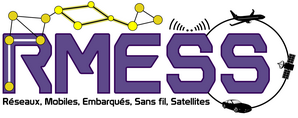Leader: Riadh Dhaou
In recent years, satellite networks have evolved from the first geostationary satellite networks, used for broadcasting, to future Low Earth Orbit (LEO) constellations or very high-throughput satellites. Through these evolutions, the question of the harmonious operation between satellite and terrestrial components has been posed recurrently. The RMESS team is looking for solutions adapted to the use of satellite links for communications whether in the framework of current (mainly IP based) or future network architectures such as software-defined networks (SDN), content-based networks (CDN, ICN), or the 5th generation of mobile networks (5G) integrating the IoT (Internet of Things) context . Works, carried out through studies and partly through Ph. D. theses, are now moving towards the implementation of network techniques less and less specific to the satellite world. One of the active (and historical) pillars of the team activity in the network domain is unquestionably that of resource management. It is divided into two traditional axes: access methods and scheduling. Thus, work related to the resource management and the quality of service always focus on the access layer according to the evolution of the physical layers. Terrestrial transport protocols are significantly degraded in a satellite environment because of their strong dependence on round-trip time. The RMESS team has been working in this field for several years, and its expertise in this field is strong and covers skills from levels close to the physical layer up to service levels. Besides, the advent of multihoming solutions adapted to terrestrial-satellite hybrid scenarios opens the way to the experimentation of innovative solutions for load-balancing or dynamic routing of content that are placed in a context of network hybridization. The use of several links is indeed a common practice today. The methods used in our research involve stochastic modeling and analysis, optimization, simulation, prototyping, and experimentation. The results of our research are patented or published in high-level conferences and journals and are supported by national and European funding with strong industrial involvement.
